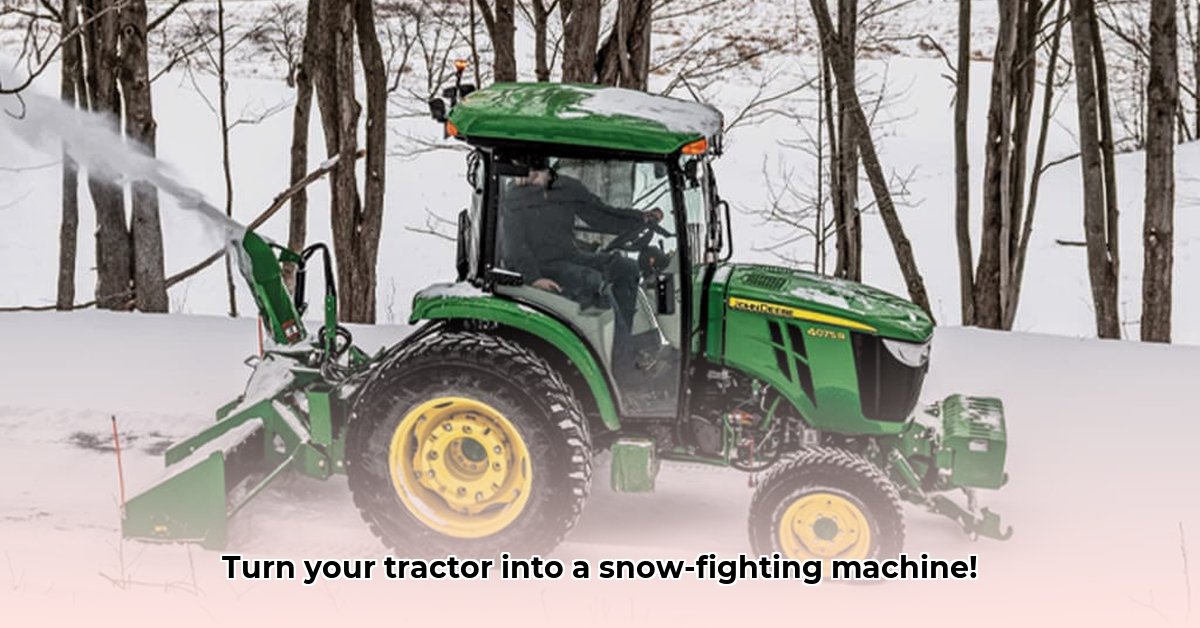
Winter's harsh snowfall doesn't have to mean endless shoveling. Maximize your tractor's versatility and transform your winter chores into an efficient, even satisfying experience. This guide will walk you through selecting the right equipment, mastering safe operation, and managing costs to make snow removal a breeze. For more detailed information on snow removal techniques, check out this helpful guide: Tractor Snow Removal Guide.
Choosing the Right Tractor and Attachments
Selecting the optimal tractor and attachments depends on several key factors. Consider the size of your property, typical snowfall, and, of course, your budget. Don't skimp on horsepower—it's the muscle behind snow removal. Heavier snowfalls demand more powerful tractors to ensure efficient clearing.
Before purchasing, verify compatibility between your tractor and desired attachments (snow plows, blowers, spreaders). Always consult the manufacturer's specifications to avoid unforeseen issues.
Tractor Horsepower and Attachment Compatibility
Horsepower: This dictates the tractor's snow-moving power. Higher horsepower handles heavier snowfalls more effectively. Consider your local climate and snowfall averages. A tractor with inadequate horsepower struggles significantly in heavy snow, potentially leading to damage.
Attachment Compatibility: Not all attachments are compatible with all tractors. Check your tractor's specifications to ensure it can handle the weight and hydraulic requirements of your chosen attachments.
Types of Snow Removal Attachments
Different attachments excel in varying snow conditions:
| Attachment Type | Advantages | Disadvantages | Ideal Conditions |
|---|---|---|---|
| Straight Blade | Simple, affordable, easy to operate | Less effective in deep snow; limited maneuverability | Light to moderate snowfall; flat, open areas |
| V-Plow | Excellent maneuverability; efficient in tight spaces | More expensive than straight blades; requires more skill | Moderate to heavy snowfall; varied terrain |
| Snow Blower | Handles deep snow effectively; throws snow far away | Requires higher horsepower; higher initial cost | Heavy snowfall; large areas requiring quick clearing |
| Spreader | Efficiently distributes de-icing materials | Requires additional purchase; requires careful calibration | For maintaining clear pathways after plowing |
Do you have a large acreage with complex landscaping? A V-plow's maneuverability becomes invaluable. For areas with consistent heavy snow, a snow blower becomes a far more efficient and time-saving option. Remember, choosing the right tools is crucial for effective snow removal.
Step-by-Step Guide to Attachment Installation and Operation
Safe installation is paramount. Always consult your tractor's owner's manual—it is your primary safety guide. Here's a general procedure:
Preparation: Park on level ground, turn off the engine, and securely engage the parking brake. This minimizes the risk of accidental movement.
Attachment Connection: Carefully align the attachment with the tractor's hitch points. Follow manufacturer instructions for secure fastening. Incorrect installation can lead to significant safety hazards.
Hydraulic Hookup: Connect hydraulic lines correctly. Double-check connections to avoid leaks and potential malfunctions.
Testing: Before full operation, conduct a test run in a controlled environment to ensure everything functions smoothly and safely.
Operation: Operate slowly and cautiously, avoiding sudden movements. Always maintain awareness of your surroundings and potential hazards.
Remember, never operate a tractor without proper training and a thorough understanding of safety procedures.
Maintenance and Repair: Keeping Your Equipment Running Smoothly
Proactive maintenance extends your equipment's lifespan and minimizes costly repairs. Follow these regular maintenance steps:
- Regularly inspect hydraulic lines for leaks or damage.
- Lubricate moving parts according to the manufacturer’s recommendations.
- Check and tighten all bolts to ensure secure connections.
- Thoroughly clean your equipment after each use to prevent corrosion.
Addressing minor issues promptly reduces the risk of major problems later. If repairs are needed, consult a qualified mechanic or your local tractor dealer.
Cost Considerations: Budgeting for Your Snow Removal Investment
The initial investment for a tractor and attachments is significant. Research various financing options from your local dealer or financial institutions. Factor in ongoing costs such as fuel, maintenance, and potential repairs to get a clear picture of overall expenses. While higher-quality equipment may have a higher upfront cost, it often translates into lower long-term maintenance expenses.
Legal and Regulatory Compliance: Operating Safely and Responsibly
Always adhere to local safety and environmental regulations. This includes following road safety laws if using your tractor on public roads and responsibly disposing of snow and de-icing materials to minimize environmental impact. Your local municipality may have specific regulations regarding snow removal and de-icing agents.
Conclusion: Clearing the Way for Winter Success
By carefully selecting the appropriate equipment, adhering to safety guidelines, and performing routine maintenance, you can turn your tractor into a powerful ally against winter's snowy challenges. Contact your local tractor dealer for assistance in selecting the optimal equipment to meet your specific needs.